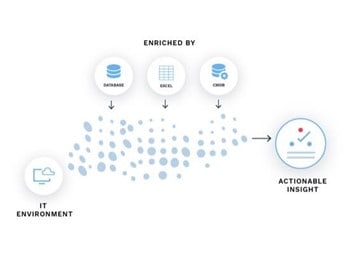
Observability for DevOps and Operations allows teams to focus on developing better services with superior customer experience.
Operational and telemetry data are the lifeblood of observability. Before it can do anything, an observability solution must ingest, normalize, and enrich the source data generated by your monitoring tools, including log events, metrics, traces and alerts – while applying artificial intelligence (AI) and machine learning, all in real-time. A major advantage of an AI-based observability solution is the ability to ingest different types of data across siloed technology stacks, use algorithms to filter for deduplication, and organize the data to reduce event noise and minimize incident volumes.
SRE and IT Operations teams can gain complete visibility across the production environment with the aggregation of event data, log files, streaming data, SNMP, email, and message bus across cloud and on-premises services for applications, services, and infrastructure. This outcome is an enabler of developing better services with superior customer experience.
Step one: Ingesting any observability data you need
The first step in observability workflow is bringing data into the solution. Observability of a modern environment requires flexible data ingestion. Solutions typically provide APIs to ingest various types of observability data. For example, an inbound metrics API will provide an endpoint where you can send time-series metrics from your monitoring services for correlation by the observability solution.
Be prepared to do some customization if you want to ingest more obscure but important data sources. If the observability data is vital for ensuring your business apps and services remain continuously available, you need to get it into the solution. Some solutions will provide tools for custom integration, which makes it easier for you to ingest whatever data you need – from any system or service. This is a valuable feature, for it lets you easily integrate data from any tool that you are already using and trust.
Getting more context with data enrichment
Most companies face a proliferation of vendor-specific management software, which is quickly draining corporate IT budgets and productivity with no end in sight. A recent Enterprise Management Associates study found that nearly 25 percent of large enterprises have eight or more network performance monitoring (NPM) tools currently installed, with some supporting as many as 25.
As such, another important element of observability is for a solution’s ability to integrate with critical information systems such as configuration management databases, discovery systems, build management systems, and DevOps tool-chains. The observability solution should add key information such as location, department, business criticality, service relationships, owner, production status, and class. By providing this context within the alerts, observability will help teams gain actionable insights: situational awareness, understanding of interdependencies and relationships, and ability to resolve incidents quickly. Ideally, this integration should be API-driven and fully automated to reduce the burden or “toil” on the operations staff.

AI can self-enrich data with algorithms
A unique benefit of AI in an observability solution is the ability to “enrich itself” without using external intelligence feeds. Algorithms parse the data for “features” – keywords or pieces of information – to automatically populate other fields. Algorithms can also combine values in fields to equate to a value in another field. This metadata, in the form of “tags” or “labels” while useful for users, is also useful for downstream machine processing, or integration with other applications. Capabilities like these eliminate the hassle and often impossibility of easily correlating external feeds along with the mountain of internal operations and telemetry data.
With AI, instead of being a giant obstacle, the data are now the enabler of actionable insights that were heretofore unavailable with legacy monitoring. Self-enrichment helps to make teams smarter with full enterprise observability.
Achieving full enterprise observability with cross-domain enrichment
The last step to getting full enterprise observability is cross-domain data enrichment. This adds key information for algorithms such as location, department, business criticality, service relationships, runbooks, and escalation processes. DevOps, SRE, and other operations teams will be able to see everything to resolve incidents quickly with the optimization of three observability processes:
- Operational: Functionally modifies behavior within the observability solution to drive processes such as clustering. This should ideally be performed on alert creation.
- Diagnostic: Assists operators to investigate incidents and can be performed at either the alert or situation level. Examples include updates to custom information and situation discussion threads.
- Informational: Assists IT Ops, SREs and DevOps teams with informational updates to the situation description, services, and processes for ease of use and situational awareness.
The AI-based observability processes using data ingestion and enrichment will bring your organization three substantial benefits. These include 360-degree visibility across technology stacks from a central system of engagement; reduction of event noise by up to 99 percent; and getting accurate context and situational awareness for rapid remediation of issues. By letting AI do the work, teams will be able to focus their valuable time on developing better services with superior customer service.






